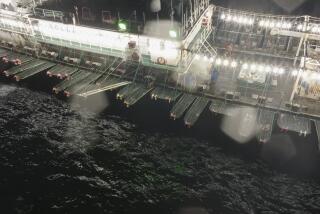Remedies keep seasickness at bay
At some point, almost every traveler suffers from seasickness or some other form of motion sickness. Mal de mer, as the French call it, is so common on cruise ships that some lines dispense anti-nausea pills free of charge. Remember, your vulnerability to seasickness is not a reflection of your fortitude or machismo. Even actor George Clooney was stricken during the filming of the seafaring movie saga “The Perfect Storm.”
Doctors think motion sickness stems from conflicting signals from your brain and body. The balance mechanism in your inner ears and the nerves in your feet tell your brain you’re moving, but your eyes see a motionless deck and cabin and send signals that you’re not moving. The conflicting signals cause confusion in your brain, resulting in nausea, dizziness and sweating.
If these symptoms sound familiar, here are a few tips on combating nausea on the high seas.
Take action before you get on board
Bigger ships rock and roll less on choppy waters, so if you are susceptible to seasickness, book your cruise on a bigger ship. For example, Princess Cruises’ Caribbean Princess, which carries about 3,100 passengers, will offer a steadier ride than the line’s Pacific Princess, which holds about 670 passengers.
Also, plan your trip with weather and the seasons in mind. For example, you might want to avoid a cruise in the Gulf of Mexico during hurricane season, which is June through November. You can also expect rough seas in the winter in the North Atlantic, off western France and around Cape Horn, off the southern tip of Chile.
Dr. John Bradberry, medical director for Carnival Cruise Lines, suggests that passengers who are susceptible book a cabin near the middle of the ship and below the waterline -- the equivalent, he says, of sitting in the middle of a playground seesaw instead of at an end. He also suggests cruise passengers eat moderately and avoid excessive alcohol throughout the cruise.
Consider over-the-counter cures
You usually can control your symptoms with one of the nonprescription drugs such as meclizine (sold under the brand names Antivert, Bonine, Meni-D, Antrizine) and dimenhydrinate (Dramamine, Gravol and Vertirosan). These suppress the mechanism that transmits signals from the inner ear, thus minimizing the conflict in your brain.
Dimenhydrinate makes many people drowsy, but meclizine produces fewer side effects, doctors say. Be sure to take the medication several hours before boarding, because the drugs need time to take effect. And check with your doctor to make sure there’s no negative interaction with any medication you’re taking.
Seasickness patches mete out a drug called scopolamine through the skin behind your ear. The patches release small amounts of the drug for several days, keeping nausea at bay for long periods of time. But doctors say scopolamine has been tied to such side effects as delusions and delirium among the elderly, and vision problems for people who accidentally get the medication on their fingers and rub their eyes.
Dr. Arthur Diskin, vice president and chief medical officer for Royal Caribbean Cruises, suggests you try the patches a day before your cruise to see if you suffer side effects. Also check with your doctor before trying the patches.
Think about alternative methods
Some cruisers swear that chewing on ginger or taking ginger tablets reduces nausea at sea, although doctors say medical studies have yet to show it offers any substantial relief.
Other cruise veterans put their faith in acupressure bracelets that are designed to stop nausea by pressing on a pressure point just above the wrist.
But to trigger the pressure point that stimulates the part of the brain that controls balance, a bracelet would have to be worn so tightly that it could cut off circulation, said Dr. Malcolm Taw, an assistant clinical professor of East-West medicine at UCLA.
Instead of ginger or bracelets, doctors say you can reduce your nausea by standing on the deck of your ship, breathing in fresh air and keeping your eyes on the horizon.
Watch out for long-lasting motion of the ocean
Besides seasickness, some cruise guests also suffer from mal de debarquement, the feeling that the ground is moving after you’re off the ship. When you board, your brain adjusts to the motion of the ship -- which some people call getting your “sea legs.” But once back on terra firma, doctors say your brain must readjust. For many people, this can take a few hours, but for others, this problem lasts for months or years after disembarking, said Dr. Yoon-He Cha, a UCLA neurologist who is seeking a cure.
hugo.martin@latimes.com
More to Read
Sign up for The Wild
We’ll help you find the best places to hike, bike and run, as well as the perfect silent spots for meditation and yoga.
You may occasionally receive promotional content from the Los Angeles Times.






